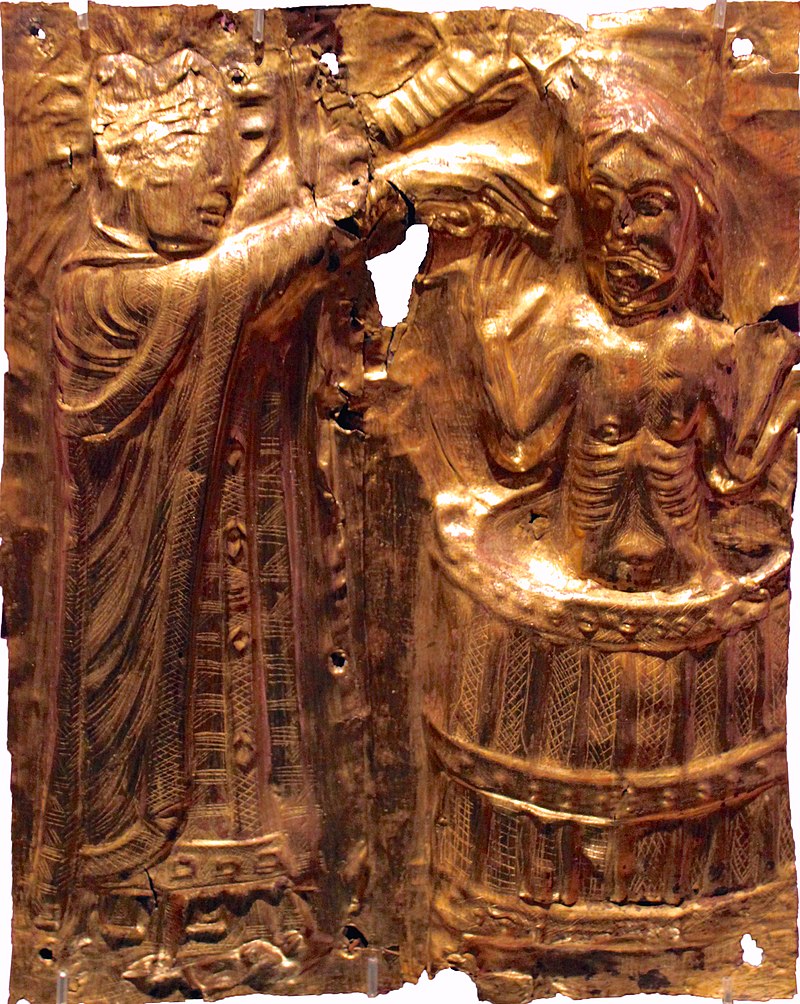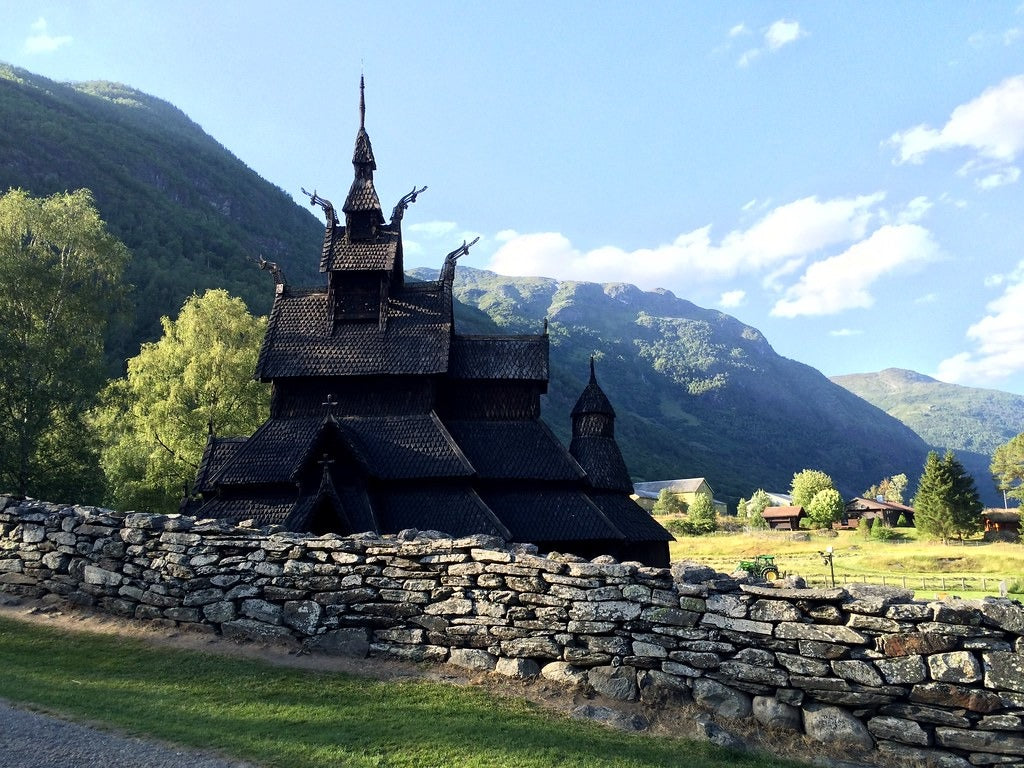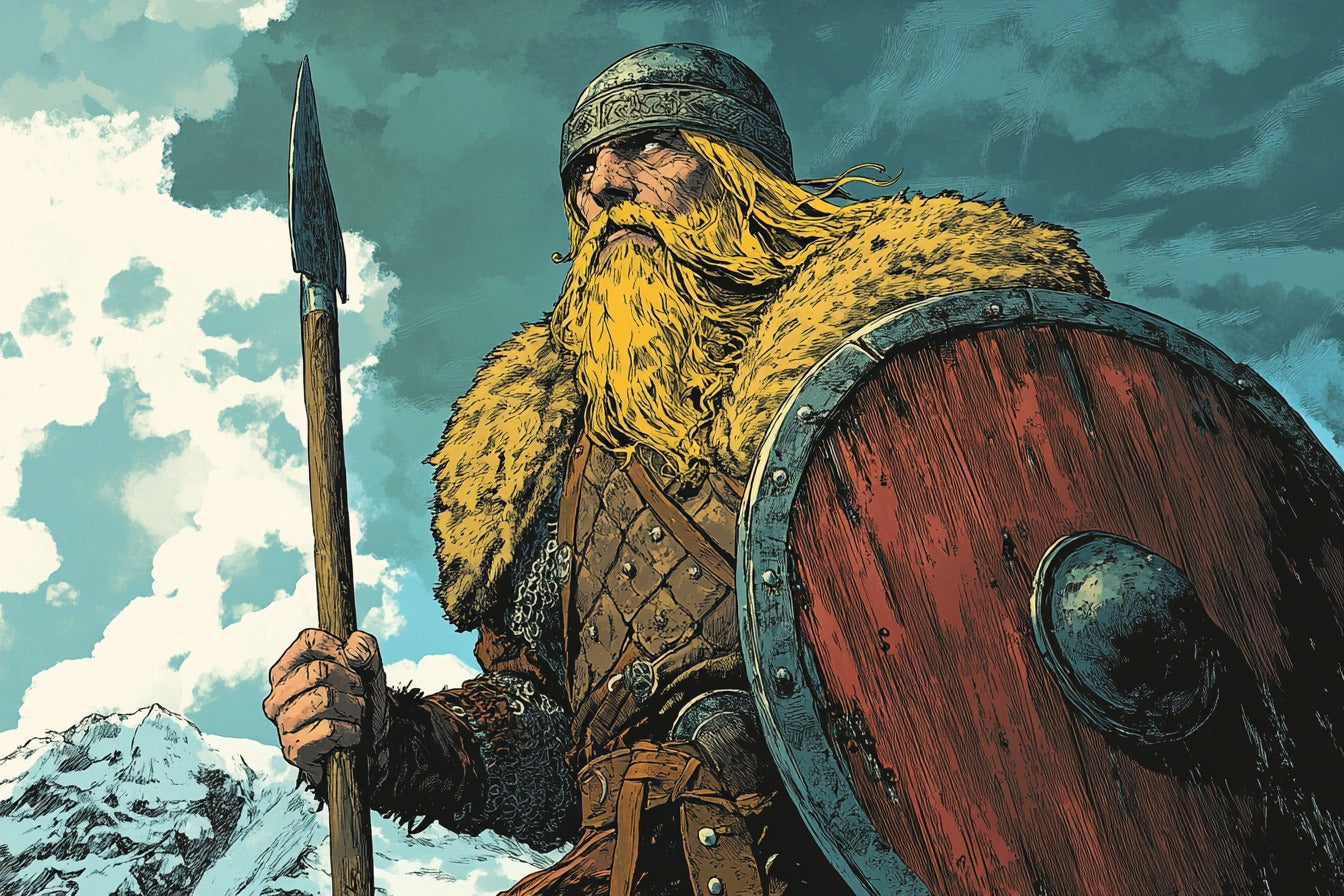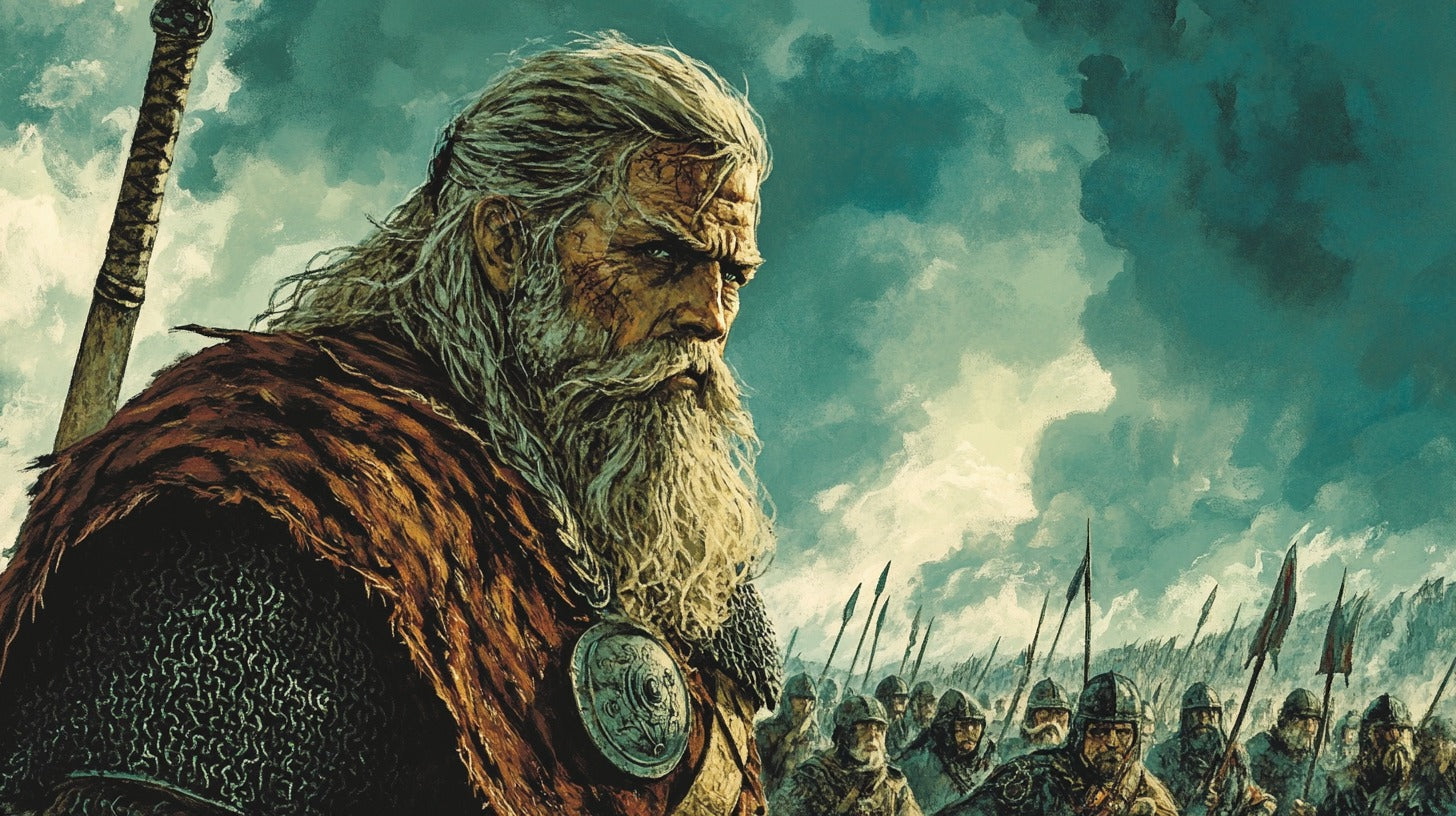
King Gorm and the Foundations of Medieval Denmark
King Gorm, a ruler shrouded in mystery, stands as a colossus at the threshold of Denmark's recorded history. His reign, much like the foggy fjords of his homeland, obscures as much as it reveals, leaving us to piece together the fragments of a legacy that would shape the destiny of a nation.
Early Life and Rise to Power

Origins and Family Background
The tale of Gorm begins not with a thunderous battle cry, but with whispers and speculation. Like a tree whose roots delve deep into the earth, Gorm's lineage remains a subject of scholarly debate. Some say he sprang from the loins of the legendary Ragnar Lodbrok, while others claim more humble origins. The truth, like a clever fox, eludes our grasp, darting between fact and fiction with maddening agility.
What we do know is that Gorm emerged from the turbulent seas of 10th century Scandinavia, a time when power was as fleeting as the northern lights and as coveted as dragon's gold. His early years, much like the harsh Danish winters, likely forged him into a man of iron will and keen ambition.
Ascension to the Danish Throne
Gorm's rise to power was not a gentle spring breeze, but a howling gale that swept across the land. The Denmark of his time was a patchwork of petty kingdoms, each vying for supremacy like wolves fighting over a carcass. How Gorm managed to claw his way to the top of this blood-soaked heap is a tale worthy of the skalds.
Did he conquer through brute force, his longships striking terror into the hearts of his rivals? Or was he a master of diplomacy, weaving alliances as intricate as the patterns on a Viking shield? The sagas are frustratingly silent on these matters, leaving us to imagine the cunning and strength that must have propelled Gorm to the Danish throne.
Gorm's Reign and Political Landscape
Consolidation of Power in Denmark
Once seated upon his hard-won throne, Gorm faced the Herculean task of holding it. Denmark, like a wild horse, bucked beneath him, resistant to the reins of centralized authority. With the patience of a master craftsman and the ruthlessness of a seasoned warrior, Gorm set about binding the fractious elements of his kingdom into a cohesive whole.
His methods, lost to time, must have been a blend of carrot and stick, of wisdom and ferocity. Perhaps he offered lands and titles to those who bent the knee, while his sword drank deep of those who dared to resist. The result was a Denmark more united than ever before, a foundation upon which future kings would build an empire.
Relations with Neighboring Kingdoms
Gorm's Denmark did not exist in isolation, but as part of a complex web of alliances, rivalries, and tenuous peace treaties. To the south lay the Holy Roman Empire, a sleeping giant that could crush Denmark like a grape if roused. To the east, the Swedes and Norwegians watched with hungry eyes, their own ambitions barely contained by the narrow straits separating their lands.
How did Gorm navigate these treacherous waters? Did he send emissaries laden with gifts and honeyed words? Or did he rely on the fearsome reputation of Danish warriors to keep potential invaders at bay? The chronicles offer tantalizingly few details, leaving us to marvel at the diplomatic acumen that must have been required to keep Denmark intact during these turbulent times.
The Jelling Stones and Archaeological Evidence

Significance of the Jelling Monuments
If Gorm's reign is a puzzle, then the Jelling stones are its cornerstone pieces. These massive runestones, erected in the heart of Denmark, offer us a rare glimpse into the mind of a king long dead. The smaller of the two, commissioned by Gorm himself, stands as a testament to his love for his wife Thyra, whom he calls "Denmark's Salvation."
This stone, weathered by centuries of wind and rain, speaks volumes about Gorm's character. Here was a man capable of great tenderness, who saw fit to immortalize his queen in stone. Yet, it also hints at Thyra's own power and influence, raising tantalizing questions about the nature of their partnership and her role in shaping Denmark's destiny.
Insights into Gorm's Rule from Archaeological Findings
Beyond the Jelling stones, the earth itself has slowly yielded secrets about Gorm's reign. Archaeologists, like detectives sifting through millennia-old crime scenes, have unearthed tantalizing clues about life in 10th century Denmark. Coins bearing Gorm's name speak to a sophisticated economy, while the remnants of fortifications hint at a ruler keenly aware of the need for defense.
But perhaps most intriguing are the grave goods found in burials dating to Gorm's time. Rich in both quantity and quality, they paint a picture of a society at the height of its power and wealth. Was this prosperity a direct result of Gorm's policies? Or did he simply have the good fortune to rule during a time of plenty? The artifacts, beautiful though they may be, keep their secrets close.
Gorm's Family and Dynasty
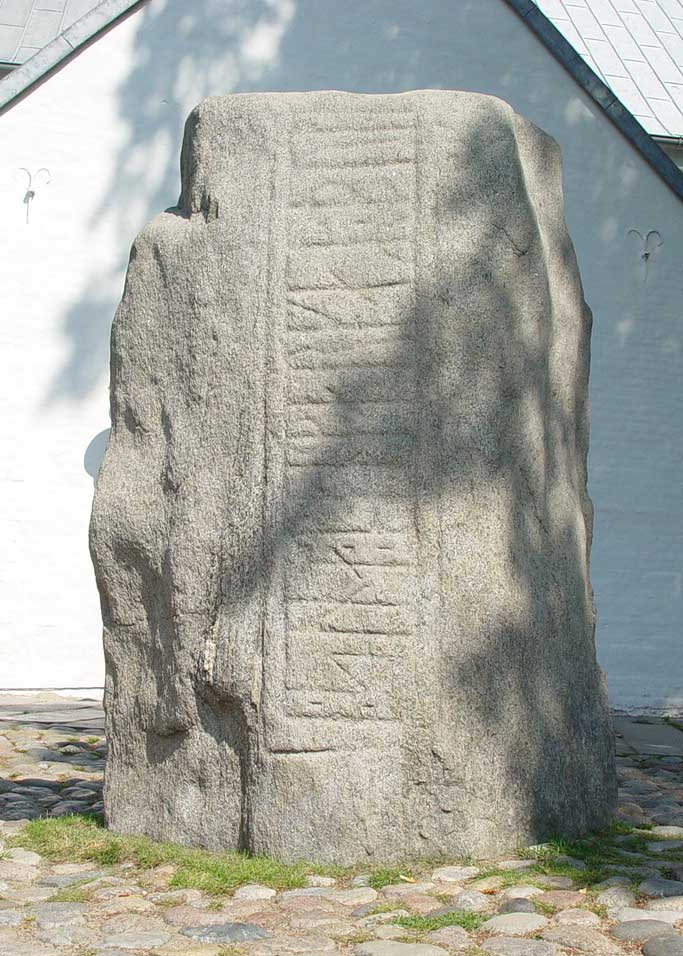
One of the Jelling Stones (front side) for Thyra / Photo: Jürgen Howaldt
Marriage to Thyra Dannebod
At the heart of Gorm's story lies his marriage to Thyra, a woman as shrouded in mystery as her husband. Known as "Dannebod," or "Pride of Denmark," Thyra was clearly no mere ornament at Gorm's side. The legends speak of her wisdom, her beauty, and her indomitable spirit. Some even credit her with the construction of the Danevirke, a massive fortification system that protected Denmark's southern border.
Their union, whether born of love or political necessity, proved to be the bedrock upon which the future of Denmark would be built. Together, Gorm and Thyra stood as the progenitors of a dynasty that would shape Scandinavian history for generations to come.
Children and Heirs
From the union of Gorm and Thyra sprang the seeds of Denmark's future. While the exact number of their children remains uncertain, one name stands out like a beacon in the fog of history: Harald.
Harald Bluetooth: Gorm's Famous Son
Harald, later known as "Bluetooth," would go on to eclipse his father in fame, if not in deed. Under his rule, Denmark would embrace Christianity, forever altering the cultural and political landscape of Scandinavia. But was this the future Gorm envisioned for his son and heir? Did the old king, steeped in the traditions of his forefathers, look upon the changing times with approval or dismay?
Bishop Poppo the missionary baptising Harald Bluetooth in 960 / Photo: Anagoria
The sagas are silent on these matters, leaving us to wonder about the conversations that must have taken place between father and son. Did Gorm, in his final years, sense the winds of change that were about to sweep across his beloved Denmark? And if so, how did he prepare Harald for the challenges that lay ahead?
Legacy and Impact on Danish History
Founding the Jelling Dynasty
Gorm's greatest achievement, perhaps, was not any single act of conquest or governance, but the establishment of a dynasty that would rule Denmark for generations. The Jelling dynasty, named after the site of Gorm's royal seat, would go on to produce some of the most influential rulers in Danish history.
This continuity of rule provided Denmark with a stability that was rare in those turbulent times. It allowed for the development of institutions, the codification of laws, and the gradual emergence of a distinct Danish identity. In many ways, the modern nation of Denmark can trace its roots back to the foundations laid by Gorm and his descendants.
Influence on Viking Age Denmark
Gorm's reign marked a turning point in Danish history. Under his rule, Denmark began its transformation from a collection of warring tribes into a unified kingdom capable of projecting power across the North Sea and beyond. The Viking raids, which had been a defining feature of Scandinavian interaction with the rest of Europe, began to give way to more organized forms of conquest and colonization.
This shift, while perhaps not fully realized during Gorm's lifetime, set the stage for Denmark's emergence as a major player on the European stage. The seeds of empire, planted in the fertile soil of Gorm's united kingdom, would eventually blossom into a Scandinavian powerhouse that would dominate northern Europe for centuries to come.
Myths and Legends Surrounding King Gorm

The Tale of Thyra's Danevirke
Like all great figures of the past, Gorm has accumulated a wealth of legends around his name. One of the most enduring is the story of Thyra's construction of the Danevirke. According to this tale, while Gorm was away on a military campaign, Thyra took it upon herself to fortify Denmark's southern border against Saxon incursions.
The legend speaks of Thyra's cleverness and determination, as she rallied the people of Denmark to build a massive earthwork fortification in record time. When Gorm returned, he was said to have been so impressed by his wife's initiative that he granted her a large portion of his kingdom as a personal fief.
While historians debate the veracity of this tale, it nonetheless offers valuable insights into how later generations viewed Gorm and Thyra. The story paints a picture of a power couple, each complementing the other's strengths and working together for the good of Denmark.
Gorm's Supposed Paganism and Conversion
Another persistent legend surrounding Gorm is the question of his religious beliefs. Many later chroniclers portrayed Gorm as a staunch pagan, resistant to the encroaching tide of Christianity that was sweeping across Europe. Some tales even speak of his violent opposition to the new faith, describing him as a persecutor of Christian missionaries.
Yet, other stories suggest that Gorm may have converted to Christianity late in life, possibly influenced by his son Harald's embrace of the new religion. The truth, as is often the case with such matters, likely lies somewhere in between these extremes.
What these legends do reveal, however, is the central role that religion played in the political and cultural upheavals of Gorm's time. The tension between the old Norse gods and the Christian faith would continue to shape Danish history long after Gorm's death.
Conclusion: Gorm's Place in History
As we step back from the swirling mists of legend and peer into the harsh light of historical analysis, what emerges is a portrait of a king both ordinary and extraordinary. Gorm, for all the mystery that surrounds him, stands as a pivotal figure in Danish history – a bridge between the fragmented tribal structures of the early Viking Age and the centralized monarchy that would come to define medieval Denmark.
His reign, marked by the consolidation of power and the establishment of a lasting dynasty, laid the groundwork for Denmark's emergence as a major European power. Yet, Gorm was also a man of his time, grappling with the same challenges and uncertainties that faced all rulers in that turbulent era.
Perhaps it is this very human quality that makes Gorm such a fascinating figure. In him, we see reflected the struggles and triumphs of an entire people, standing at the crossroads of tradition and change. His legacy, like the mighty oaks of Danish forests, has deep roots that continue to nourish the soil of Danish identity to this day.
As we conclude our exploration of King Gorm's life and times, we are left with more questions than answers. But perhaps that is as it should be. For in the spaces between what we know and what we can only imagine, the true spirit of history – curious, questioning, and ever-evolving – finds its home.
FAQs
- When did King Gorm rule Denmark?
King Gorm's exact dates of rule are uncertain, but he is generally believed to have reigned in the early to mid-10th century, possibly from around 936 to 958 CE.
- Why is King Gorm sometimes called "Gorm the Old"?
The epithet "the Old" likely refers to Gorm's long reign or his status as the founder of the Jelling dynasty, rather than his actual age. It may also distinguish him from later Danish kings named Gorm.
- What major achievements are attributed to King Gorm?
Gorm is credited with unifying Denmark under a single rule, establishing the Jelling dynasty, and laying the foundations for Denmark's emergence as a powerful medieval kingdom.
- How do we know about King Gorm's existence?
Our knowledge of Gorm comes primarily from archaeological evidence, particularly the Jellinge stones, as well as later written sources and sagas that mention him.
- Did King Gorm convert to Christianity?
While Gorm is generally considered to have been pagan, there are some legends suggesting he may have converted to Christianity late in life. However, his son Harald Bluetooth is more commonly associated with Denmark's Christianization.
References
Roesdahl, E. (1982). Viking Age Denmark. London: British Museum Publications.
Sawyer, P. (1994). Kings and Vikings: Scandinavia and Europe AD 700-1100. London: Routledge.
Randsborg, K. (1980). The Viking Age in Denmark: The Formation of a State. London: Duckworth.
Jones, G. (1984). A History of the Vikings. Oxford: Oxford University Press.
Christiansen, E. (2002). The Norsemen in the Viking Age. Oxford: Blackwell Publishers.
"Jelling runenstenen" by Andrys Stienstra is licensed under CC BY-SA 4.0.
